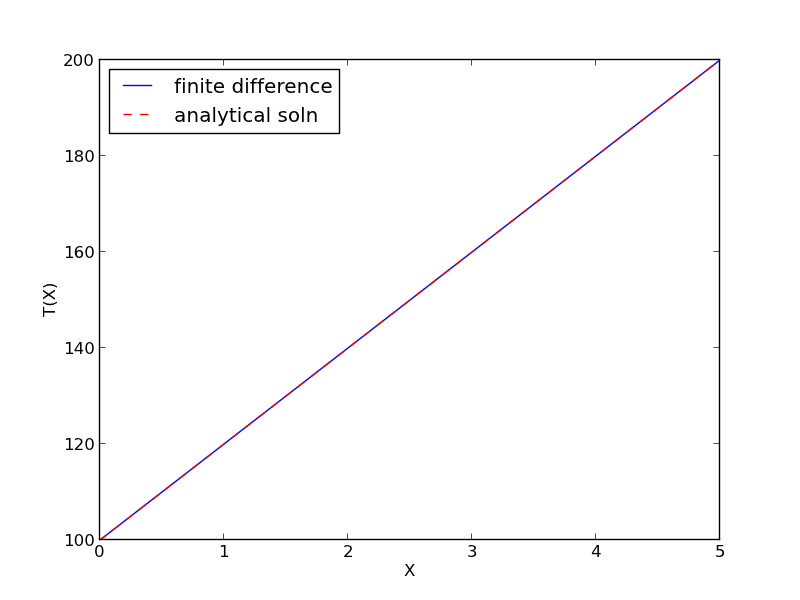Boundary value problem in heat conduction
Posted March 06, 2013 at 07:35 PM | categories: bvp | tags: heat transfer
Updated March 06, 2013 at 07:37 PM
For steady state heat conduction the temperature distribution in one-dimension is governed by the Laplace equation:
$$ \nabla^2 T = 0$$
with boundary conditions that at \(T(x=a) = T_A\) and \(T(x=L) = T_B\).
The analytical solution is not difficult here: \(T = T_A-\frac{T_A-T_B}{L}x\), but we will solve this by finite differences.
For this problem, lets consider a slab that is defined by x=0 to x=L, with \(T(x=0) = 100\), and \(T(x=L) = 200\). We want to find the function T(x) inside the slab.
We approximate the second derivative by finite differences as
\( f''(x) \approx \frac{f(x-h) - 2 f(x) + f(x+h)}{h^2} \)
Since the second derivative in this case is equal to zero, we have at each discretized node \(0 = T_{i-1} - 2 T_i + T_{i+1}\). We know the values of \(T_{x=0} = \alpha\) and \(T_{x=L} = \beta\).
\[A = \left [ \begin{array}{ccccc} % -2 & 1 & 0 & 0 & 0 \\ 1 & -2& 1 & 0 & 0 \\ 0 & \ddots & \ddots & \ddots & 0 \\ 0 & 0 & 1 & -2 & 1 \\ 0 & 0 & 0 & 1 & -2 \end{array} \right ] \]
\[ x = \left [ \begin{array}{c} T_1 \\ \vdots \\ T_N \end{array} \right ] \]
\[ b = \left [ \begin{array}{c} -T(x=0) \\ 0 \\ \vdots \\ 0 \\ -T(x=L) \end{array} \right] \]
These are linear equations in the unknowns \(x\) that we can easily solve. Here, we evaluate the solution.
import numpy as np #we use the notation T(x1) = alpha and T(x2) = beta x1 = 0; alpha = 100 x2 = 5; beta = 200 npoints = 100 # preallocate and shape the b vector and A-matrix b = np.zeros((npoints, 1)); b[0] = -alpha b[-1] = -beta A = np.zeros((npoints, npoints)); #now we populate the A-matrix and b vector elements for i in range(npoints ): for j in range(npoints): if j == i: # the diagonal A[i,j] = -2 elif j == i - 1: # left of the diagonal A[i,j] = 1 elif j == i + 1: # right of the diagonal A[i,j] = 1 # solve the equations A*y = b for Y Y = np.linalg.solve(A,b) x = np.linspace(x1, x2, npoints + 2) y = np.hstack([alpha, Y[:,0], beta]) import matplotlib.pyplot as plt plt.plot(x, y) plt.plot(x, alpha + (beta - alpha)/(x2 - x1) * x, 'r--') plt.xlabel('X') plt.ylabel('T(X)') plt.legend(('finite difference', 'analytical soln'), loc='best') plt.savefig('images/bvp-heat-conduction-1d.png')

Copyright (C) 2013 by John Kitchin. See the License for information about copying.